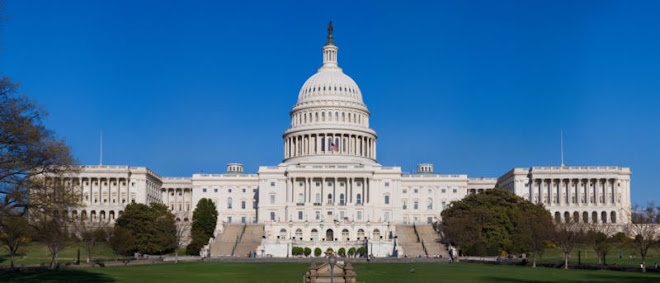From Town Hall:
Salena Zito
White House Gets It Wrong on Stimulus Jobs
Email Salena Zito
Columnist's Archive Share Buzz 0diggsdigg
Sign-Up An American Recovery and Reinvestment Act stimulus sign guards the majestic National Trust Historic Preservation building just beyond DuPont Circle in Washington, D.C.
The sign, like so many others Americans have seen along their highways the past two years, proudly marks the spot where “Your government is at work for you.”
A“Maybe it’s stimulating the grass to grow?” remarked a friend as we hustled down Massachusetts Avenue, seeing no construction in sight.
The sign has stood there for nearly a year. It provided no stimulus funding for the National Trust, or its grass. But new sidewalks are being installed behind the building, said someone answering the phone at the Trust, and the District of Columbia’s Department of Transportation “has been working on it since at least July.”
According to the district DOT’s stimulus website, the sidewalk project has been ongoing since October 2009. It does not state how many jobs were stimulated; in fairness, that probably is difficult to gauge – since the project was slated before the stimulus was enacted.
Even though the nation’s unemployment rate is at 9 percent (not the 7 percent projected by the White House, if the stimulus act worked), White House press secretary Jay Carney said Thursday that the stimulus has added “several million jobs” and “lowered the unemployment rate. … The goals of the stimulus package have been met.”
This administration still doesn’t get it, or doesn’t read its own jobs reports.
Middle America’s voters, especially those Democrats and independents who supported Obama in 2008, still feel a major disconnect with this administration.
In 2010 they told Washington that they wanted a new approach. What they were looking for most was fiscal responsibility from the federal government.
When President Obama appointed his bipartisan debt commission late last winter, a sigh went up from fiscally conservative Democrats that the White House was taking America’s demands – fiscal responsibility and bipartisanship - seriously.
Yet in his budget released last week, it is hard to find evidence that Obama incorporated any of the commission’s recommendations for cutting entitlements.
Nor did the budget provide guidelines to deal with the growth of Medicare, Medicaid and Social Security.
Voters told Washington to tighten its belt and balance its books, just as they have had to do within their own families. What they got was more out-of-control deficit spending with no regard for future implications.
Worse, Americans are not seeing the benefits of deficit spending. It's not giving them better lives. It's not fixing their problems.
Public policy is supposed to be about fixing society’s problems, and federal budgets should be about protecting the country and keeping the trains running.
Policy often is a reactionary effort by politicians to fix a problem, a deliberate plan by the government to address an issue and change people’s behaviors.
The stimulus act and the tax cuts spent a lot of money, running up the deficit and the national debt. A large percentage of stimulus spending simply went to relieving state budgets; it did not change people’s behavior, and that is bad public policy.
When proposed, the stimulus act was deemed so necessary. If true, then its money should have gone to much-needed improvements to this country's infrastructure. At least then, with so much money being spent, we’d have something to show for it. More important, we would have changed people's behaviors.
Businesses, particularly small businesses, would have created jobs leading to more permanent employment; people would have had incentives to retrain in technology, and access to improved mass transit and mass communications.
Last month, Allentown Metal Works – a century-old factory in the Lehigh Valley that Obama used as a backdrop a year ago to promote for a big jobs bill – closed.
Obama’s visit there kicked off a multi-city tour following his “jobs summit” in Washington.
Last week, Obama’s press secretary dismissed questions about the effectiveness of the stimulus act.
"We've said repeatedly that we don't want to re-litigate the battles of the past," he told a reporter.
His remark came the same day that U.S. unemployment, as measured by Gallup without seasonal adjustment, hit 10 percent in mid-February – up from 9.8 percent at the end of January.
Salena Zito
Salena Zito is a political analyst, reporter and columnist.
Salena Zito
White House Gets It Wrong on Stimulus Jobs
Email Salena Zito
Columnist's Archive Share Buzz 0diggsdigg
Sign-Up An American Recovery and Reinvestment Act stimulus sign guards the majestic National Trust Historic Preservation building just beyond DuPont Circle in Washington, D.C.
The sign, like so many others Americans have seen along their highways the past two years, proudly marks the spot where “Your government is at work for you.”
A“Maybe it’s stimulating the grass to grow?” remarked a friend as we hustled down Massachusetts Avenue, seeing no construction in sight.
The sign has stood there for nearly a year. It provided no stimulus funding for the National Trust, or its grass. But new sidewalks are being installed behind the building, said someone answering the phone at the Trust, and the District of Columbia’s Department of Transportation “has been working on it since at least July.”
According to the district DOT’s stimulus website, the sidewalk project has been ongoing since October 2009. It does not state how many jobs were stimulated; in fairness, that probably is difficult to gauge – since the project was slated before the stimulus was enacted.
Even though the nation’s unemployment rate is at 9 percent (not the 7 percent projected by the White House, if the stimulus act worked), White House press secretary Jay Carney said Thursday that the stimulus has added “several million jobs” and “lowered the unemployment rate. … The goals of the stimulus package have been met.”
This administration still doesn’t get it, or doesn’t read its own jobs reports.
Middle America’s voters, especially those Democrats and independents who supported Obama in 2008, still feel a major disconnect with this administration.
In 2010 they told Washington that they wanted a new approach. What they were looking for most was fiscal responsibility from the federal government.
When President Obama appointed his bipartisan debt commission late last winter, a sigh went up from fiscally conservative Democrats that the White House was taking America’s demands – fiscal responsibility and bipartisanship - seriously.
Yet in his budget released last week, it is hard to find evidence that Obama incorporated any of the commission’s recommendations for cutting entitlements.
Nor did the budget provide guidelines to deal with the growth of Medicare, Medicaid and Social Security.
Voters told Washington to tighten its belt and balance its books, just as they have had to do within their own families. What they got was more out-of-control deficit spending with no regard for future implications.
Worse, Americans are not seeing the benefits of deficit spending. It's not giving them better lives. It's not fixing their problems.
Public policy is supposed to be about fixing society’s problems, and federal budgets should be about protecting the country and keeping the trains running.
Policy often is a reactionary effort by politicians to fix a problem, a deliberate plan by the government to address an issue and change people’s behaviors.
The stimulus act and the tax cuts spent a lot of money, running up the deficit and the national debt. A large percentage of stimulus spending simply went to relieving state budgets; it did not change people’s behavior, and that is bad public policy.
When proposed, the stimulus act was deemed so necessary. If true, then its money should have gone to much-needed improvements to this country's infrastructure. At least then, with so much money being spent, we’d have something to show for it. More important, we would have changed people's behaviors.
Businesses, particularly small businesses, would have created jobs leading to more permanent employment; people would have had incentives to retrain in technology, and access to improved mass transit and mass communications.
Last month, Allentown Metal Works – a century-old factory in the Lehigh Valley that Obama used as a backdrop a year ago to promote for a big jobs bill – closed.
Obama’s visit there kicked off a multi-city tour following his “jobs summit” in Washington.
Last week, Obama’s press secretary dismissed questions about the effectiveness of the stimulus act.
"We've said repeatedly that we don't want to re-litigate the battles of the past," he told a reporter.
His remark came the same day that U.S. unemployment, as measured by Gallup without seasonal adjustment, hit 10 percent in mid-February – up from 9.8 percent at the end of January.
Salena Zito
Salena Zito is a political analyst, reporter and columnist.










No comments:
Post a Comment